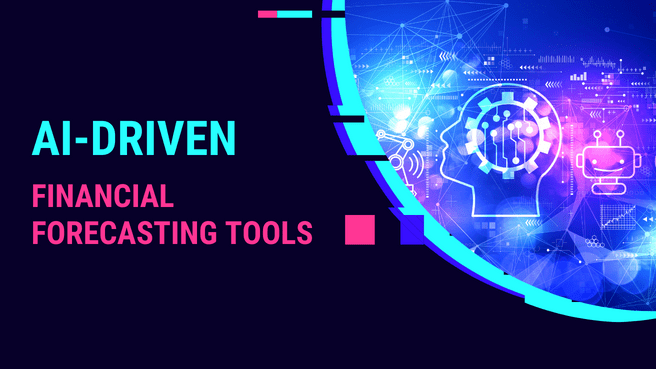In the rapidly evolving financial landscape, the ability to predict future outcomes is invaluable. AI-driven financial forecasting tools have emerged as essential assets for both individual investors and financial institutions. These tools harness advanced algorithms and machine learning to analyze large datasets, enabling users to make informed decisions with a high degree of accuracy.
The Rise of AI in Financial Forecasting
Financial forecasting involves estimating future financial outcomes based on historical data and current trends. Traditionally, this process required substantial human effort and was prone to errors due to biases and limited data processing capabilities. However, with the advent of AI-driven tools, the landscape of financial forecasting has dramatically transformed.
AI algorithms can process vast amounts of information, learning from data trends to predict future outcomes with remarkable precision. These tools consider a variety of factors, including economic indicators, market trends, and company performance metrics, making their forecasts more reliable than ever before.
Benefits of AI-Driven Financial Forecasting
One of the primary benefits of AI-driven financial forecasting is its ability to enhance decision-making processes. Financial planners and business leaders can leverage these tools to assess risk, plan investments, and anticipate market changes more effectively. This capability is crucial for maintaining a competitive edge in a volatile market.
Additionally, AI-driven forecasting tools help in minimizing human error. They provide consistent and unbiased estimates that are crucial for financial planning. This level of accuracy is particularly beneficial in complex scenarios, such as mergers and acquisitions, where precise financial projections can significantly influence outcomes.
Practical Applications in Various Sectors
AI-driven financial forecasting finds its application in numerous sectors including banking, investment, and insurance. In banking, these tools aid in assessing loan viability and risk assessment, enhancing the accuracy of credit scoring systems. For investors, AI-driven tools provide insights into stock performance trends, helping them to make more informed decisions about where to allocate their resources.
The insurance sector benefits from AI-driven forecasting by better predicting claim volumes and understanding risks, which leads to more accurate premium setting and financial planning. These applications not only improve operational efficiency but also enhance customer satisfaction by enabling more tailored services.
Real-Life Success Stories
The implementation of AI in financial forecasting has already shown promising results across various industries. For instance, JPMorgan Chase uses AI to forecast economic conditions and stock market trends, which has significantly enhanced their investment strategies. Similarly, insurance companies like Progressive have employed AI to refine risk assessment models and improve their claim management processes.
Challenges and Considerations
While AI-driven financial forecasting offers numerous benefits, it also presents challenges. The accuracy of AI predictions largely depends on the quality and quantity of the data used. Poor data quality can lead to inaccurate forecasts, potentially leading to significant financial losses.
Moreover, there is the challenge of integrating AI tools with existing financial systems. Companies must ensure that their infrastructure is capable of supporting these advanced technologies, which may require significant investments in software and training.
Future of AI-Driven Financial Forecasting
The future of AI-driven financial forecasting looks promising, with continuous advancements in AI technologies enhancing their capabilities further. The next generation of AI tools is expected to offer even more sophisticated analyses, incorporating real-time data streams to provide up-to-the-minute accuracy.
Enhancing Precision and Efficiency with AI-Driven Financial Forecasting
The integration of artificial intelligence into financial forecasting doesn’t just enhance the quality of predictions; it revolutionizes the speed and efficiency with which these forecasts can be generated. Traditional financial analysis methods can be labor-intensive and time-consuming, involving the manual examination of numerous financial statements and market indicators. In contrast, AI-driven tools synthesize this information almost instantaneously, providing forecasts at a speed that humans simply cannot match.
AI in Risk Management
One of the standout applications of AI-driven financial forecasting is in the realm of risk management. Financial institutions and companies can use AI to identify potential risks at an early stage, allowing them to take preventative measures before issues escalate. For example, AI can detect patterns indicating a probable market downturn, enabling companies to adjust their investment strategies accordingly to minimize losses.
This proactive approach to risk management is particularly important in industries where large sums of money are at stake and the cost of mistakes can be catastrophic. By leveraging AI for these purposes, businesses not only safeguard their assets but also ensure greater stability for their stakeholders.
Streamlining Operations
AI-driven financial forecasting tools also contribute to operational efficiency by automating routine tasks. These tools can automatically generate financial reports, conduct profitability analyses, and even recommend budget allocations. This automation frees up financial analysts to focus on more strategic tasks, such as interpreting complex data patterns and developing innovative financial strategies.
Furthermore, AI tools are increasingly being integrated into customer-facing applications, providing clients with instant financial insights and advice. This not only improves customer service but also enhances client engagement by providing them with personalized, data-driven recommendations.
Democratizing Financial Expertise
Another significant impact of AI-driven financial forecasting is the democratization of financial analysis. With these tools becoming more widely available, smaller firms and individual investors now have access to powerful analytical capabilities that were once reserved for large institutions. This leveling of the playing field allows a broader range of entities to compete effectively, fostering greater innovation and diversity in the financial sector.
Educational and Training Implications
The rise of AI in financial forecasting also has implications for education and professional training. As these tools become integral to financial planning and analysis, current and aspiring financial professionals need to adapt by gaining skills in data science and AI technologies. Educational institutions are beginning to incorporate these subjects into their curricula, and companies are investing in training programs to ensure their employees can effectively use these advanced tools.
Moreover, ongoing education in AI and machine learning is essential, as these fields are constantly evolving. Professionals must stay updated on the latest developments to maintain their competitive edge and fully leverage AI capabilities in their financial planning efforts.
Ethical and Regulatory Considerations
As with any technology, the adoption of AI-driven financial forecasting raises ethical and regulatory considerations. The transparency of AI algorithms, data privacy, and the potential for systemic biases are critical issues that must be addressed. Ensuring ethical AI practices involves rigorous testing and validation of algorithms, adherence to privacy laws, and ongoing monitoring to prevent discriminatory outcomes.
Regulators are also beginning to develop frameworks to oversee the use of AI in finance, aiming to ensure that these tools are used responsibly and do not contribute to financial instability. As the technology continues to permeate the financial sector, these regulatory measures will play a crucial role in shaping its development and implementation.
Conclusion: Embracing the AI Revolution
In conclusion, AI-driven financial forecasting tools are not just technological advancements; they are transformative forces that redefine how financial operations are conducted. From enhancing predictive accuracy to improving operational efficiency and democratizing financial expertise, the benefits of AI in finance are profound.
As we continue to navigate a complex and rapidly changing financial landscape, embracing AI-driven technologies will be key to achieving sustainable growth and success. These tools not only offer a strategic advantage but also drive innovation, making the financial sector more robust and responsive to future challenges. By adopting AI, the financial industry can look forward to a smarter, more efficient, and more equitable future.






